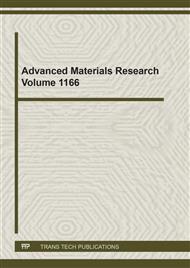[1]
A. Ghatak and K. Thyagarajan, Introduction to Fiber Optics, Cambridge University Press, (1998).
Google Scholar
[2]
T.Okoshi, Optical Fibers, Academic Press, New York, (1982).
Google Scholar
[3]
S. Mitachi, Dispersion measurement on fluoride glasses and fibers, Journal of Lightwave Technology, 7 (8), (1989), 1256-1263.
DOI: 10.1109/50.32390
Google Scholar
[4]
Govind P. Agrawal, Nonlinear Fiber Optics, 3rd ed. Academic Press, San Diego, CA, USA, (2001).
Google Scholar
[5]
T. Miyashita, T. Manabe, Infrared Optical Fibers, Microwave Theory and Techniques IEEE Transactions on, 30 (10), (1982). 1420-1438.
DOI: 10.1109/tmtt.1982.1131275
Google Scholar
[6]
S. E. Mechels, J. B. Schlager, and D. L. Franzen, Accurate Measurements of the Zero-Dispersion Wavelength in Optical Fibers, Journal of Research of the National Institute of Standards and Technology, 102 (3), (1997), 333-347.
DOI: 10.6028/jres.102.023
Google Scholar
[7]
G. Pan, N. Yu, B. Meehan, T. W. Hawkins, J. Ballato, and P. D. Dragic, Thermo-optic coefficient of B2O3 and GeO2 co-doped silica fibers, Optical Materials Express 10 (7), (2020) 1509-1521.
DOI: 10.1364/ome.397215
Google Scholar
[8]
Takashi Harada et.al., Effect of B2O3 Addition on the Thermal Stability of Barium Phosphate Glasses for Optical Fiber Devices, Journal of the American Ceramic Society 87(3), (2008), 408 – 411.
DOI: 10.1111/j.1551-2916.2004.00408.x
Google Scholar
[9]
E. D. Palik, Handbook of Optical Constants of Solids, Academic Press, New York, (1985).
Google Scholar
[10]
F. Gan, Optical properties of fluoride glasses: a review, J. Non-Cryst. Solids, 184, (1995) 9-20.
Google Scholar
[11]
U.C. Paek, Dispersion-less single mode fibers with trapezoidal index profile in the waveguide region near 1.5μm, Applied Optics, 22(15), (1983), 2363–2369.
DOI: 10.1364/ao.22.002363
Google Scholar
[12]
G.L. Yip and J. Jiang, Dispersion studies of single mode triangular index fiber with a trench by the vector mode analysis, Applied Optics, 29 (1990), 5343- 5352.
DOI: 10.1364/ao.29.005343
Google Scholar
[13]
G.P. Agarwal, Optical fiber communication system, 4th Ed., John Wiley & Sons Inc, New York, (2010).
Google Scholar
[14]
S. Yoo, Y. Jung, J. Kim, J.W. Lee and K. Oh, W-type fiber design for application in U and S band amplifiers by controlling the LP01 mode long wavelength cut-off , Optical Fiber Technology, 11 , (2005), 323-345.
DOI: 10.1016/j.yofte.2005.01.002
Google Scholar
[15]
A. Rostami and S. Makouei, Modified W-type single- mode optical fiber design with ultra low, flattened chromatic dispersion and ultra- high effective area for high bit rate long haul communications, Progress in Electromagnetics Research C, 12, (2010) 79-92.
DOI: 10.2528/pierc09090603
Google Scholar
[16]
M. A. Ettabib, F. Parmigian, X. Feng, I. Jones., J. Kakande, R. Slavik, Poletti F., G. M. Ponzo, J. Shi, M.N. Pertovich and W.H. Loh, Phase regeneration of DPSK signals in a highly nonlinear lead-silicate W-type fiber, Optics Express, 20, (2012) 27419- 27424.
DOI: 10.1364/oe.20.027419
Google Scholar
[17]
A.M. Kurbatov and R.A. Kurbatov, Polarization and modal filters base on w-fibers panda for fiber optic gyroscopes and high power fiber lasers, Optical Engineering, 52, (2013) 035006-16.
DOI: 10.1117/1.oe.52.3.035006
Google Scholar
[18]
B. Mukherjee, Optical communication networks, McGraw-Hill, New York., (1997).
Google Scholar
[19]
J. Berthold, A. M. Saleh, L. Blair and M. Simmons-Jane, Optical networking: past, present, and future, IEEE/OSA Journal of Light wave Technology. 26(9), (2008), 1104-1118.
DOI: 10.1109/jlt.2008.923609
Google Scholar
[20]
João Pedro and Nelson Costa, Optimized Hybrid Raman/EDFA Amplifier Placement for DWDM Mesh Networks, Journal of Light wave Technology, 36 (9), (2018), 1552-1561.
DOI: 10.1109/jlt.2017.2783678
Google Scholar
[21]
Y. Lu, C. Baker, L. Chen and X. Bao, Study of chromatic dispersion impact on nonlinear interaction between two sinusoidally modulated optical signals using theory of four-wave mixing,, Journal of Optical Society of America B, 33(1), (2016)110–115.
DOI: 10.1364/josab.33.000110
Google Scholar
[22]
G. P. Agarwal., Nonlinear fiber optics: its history and recent progress", Journal of Optical Society of America B,, 28, (2011).
Google Scholar
[23]
T. Kimura, Basic concepts of the optical waveguide. Optical Fiber Transmission. Ed. K. Noda. North Holland Studies in Telecommunication, 6, North Holland, Amsterdam. (1986).
Google Scholar
[24]
A.C. Mendez and H.R.D Sunak, Chromatic dispersion characteristics of single mode mid-infrared fibers Proc. SPIE. 722, 1986, 111.
DOI: 10.1117/12.937653
Google Scholar
[25]
C. Jauregui, J. Limpert, and A. Teunnermann, High-power fibre lasers, Nature. Photonics 7, 861 (2013).M. E. Fermann and I. Hartl, Nat. Photonics 7, 868(2013).
DOI: 10.1038/nphoton.2013.273
Google Scholar
[26]
M. Zervas and C. Codemard, High Power Fiber Lasers: A Review, IEEE J. Sel. Top. Quantum Electron. 20, 219 (2014).
Google Scholar
[27]
D.A. Pinnow, F.W. Dabby, I. Camlibel, A.W. Warner, L.G. Van Uitert , Preparation of high purity silica Material, Research Bulletin, 10, (1975) 1263-1266.
DOI: 10.1016/0025-5408(75)90084-7
Google Scholar
[28]
J. Kirchhof, S. Unger, B. Knappe. Fluorine containing high-silica glasses for speciality optical fibers. Advanced Materials Research, 39-40, (2008), 265-268.
DOI: 10.4028/www.scientific.net/amr.39-40.265
Google Scholar
[29]
Volkmar Bruckner, Elements of Optical Networking - Basics and Practice of Optical Data Communication, Springer. (2011).
Google Scholar
[30]
S.D Carson, R.D. Maurer, Optical attenuation in Ti-silica glasses, Journal of Non-Crystalline Solids, 11, (1973),368-380.
DOI: 10.1016/0022-3093(73)90025-2
Google Scholar
[31]
M. Kamradek, I. Kasik, P. Peterka, J. Aubrecht, P. Honzatko, O. Podrazky, J. Mrazek, V. Kubecek, Silica- and germanate- based glasses doped with rare-earth elements for photonics devices. In: Proc. 25th International Congress on Glass, (2019), Boston.
DOI: 10.1109/jphot.2019.2940747
Google Scholar
[32]
T. Kimura, Basic concepts of optical waveguide, Optical fiber Transmission. North Holland Studies in Telecommunications. Holland. Amsterdam. (1986).
Google Scholar
[33]
A.C. Mendez and H.R.D. Sunak, Chromatic dispersion characteristics of single mode mid-infrared fibers. Proc.SPIE 722.111, (1986).
DOI: 10.1117/12.937653
Google Scholar
[34]
I. Kasik, V. Matejec, M. Hayer, M. Kamradek, O. Podrazky, J. Mrazek, P. Peterka, P. Honzatko, Glass Materials for Optical Fibers. Ceramics, Silikaty 64(1), (2020), 1-9.
DOI: 10.1109/icton51198.2020.9203173
Google Scholar


